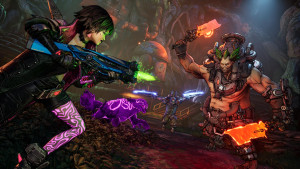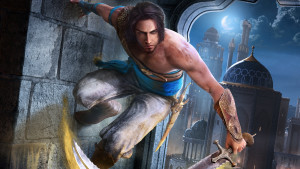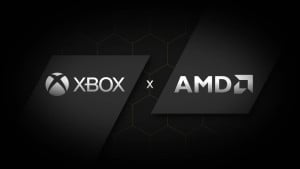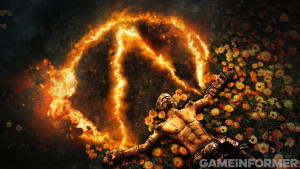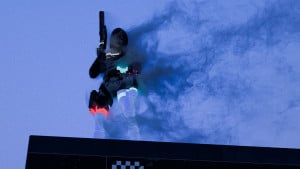The magazine is back. Get your subscription now!
Telling The Story Without Cutscenes In Infamous Second Son

Sucker Punch’s Infamous Second Son does an excellent job of developing its characters and delivering narrative outside of its cutscenes. Delsin Rowe’s story is one that lives inside of an interactive medium, and though many of its important beats are displayed without the player’s interaction, there are a number of small touches throughout that help create a sense of participation in the world as opposed to simple spectatorship.
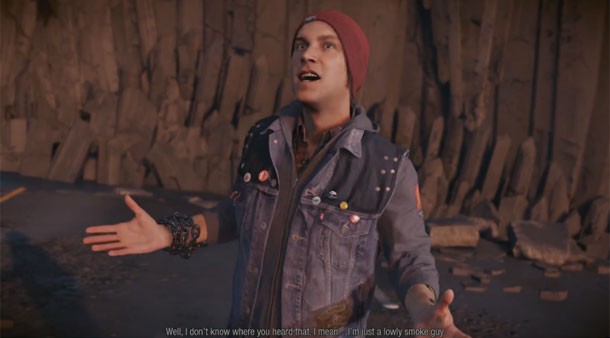
It’s your decision
One of the game’s first bosses occurs shortly after Delsin Rowe tracks down his second power. At this point in the game, Rowe has been causing a ruckus in Seattle, drawing the attention of his nemesis, and the woman who set him on his journey, Augustine. She has heard you have developed new powers, but is only knows of your smoke abilities. Rowe is placed in a battlefield affording him with only the opportunity to recharge his new powers. He enters the arena with a small cache of his smoke powers, but once he uses it up in the battle, there is no outlet to get more. You can hold your own for a little while against the boss with what little smoke abilities you have left, but eventually, your limitations force you to change tactics and show off your new ability. Exposing your new power is required for the story to move forward, but the player has to make the decision outside of a menu or a cutscene in order to progress. The choice is still ultimately made for you based on the limitations of the battlefield, but it offers a fantastic sense of ownership over the choice.

Letting the player figure it out
Each time you gain a new power, your previous powers are temporarily disabled. From a gameplay perspective, this is done in order to prevent players from immediately returning to the powers they are comfortable with and forgoing the new, initially weaker abilities. Discovering your old powers have been disabled occurs when the player tries to use them. Rowe comments on what’s happening without entering a cutscene. This could have easily been explained in the cutscene when you gain a new power, but letting the player discover it on their own by trying to use them makes the situation much more effective.
The scene that plays out after gaining your third power is particularly interesting, as Rowe isn’t even able to fire a new weapon from his palm. The world that was once your playground of explosions and mayhem becomes dangerous when suddenly you are just a human again. You only walk a few blocks, but it’s a tense experience, and one that takes place entirely in-game.

The way you play
A reasonable complaint levied against all of the Infamous games is in the choices. It’s very clear whether you’re making the good or evil decision, and they do little to change the story until the very end. Where your decisions make a stronger impact, I would argue, is in the quick decisions you make during gameplay on your good or evil path. It would be easy to relegate all of Rowe’s good or evil choices to cutscenes, but the way you play drastically affects your temperament and your personal emotion.
A good example of this is the assorted cages holding conduit prisoners throughout the game. During my good playthrough, before entering a firefight, I would unlock those cages first, freeing the prisoners in order keep them away from harm before a fight would ensue. On my evil playthrough, I ignored the cages, thankful when they were destroyed in the crossfire. Rewards of additional experience points are put in place for good players to play carefully and for evil players to cause mayhem, encouraging you to remain in character as you play. The Rowe I played as in my two playthroughs made good and evil decisions during cutscenes that directed the story, but more importantly, I approached the game from two different gameplay angles. As a result, I played as different people. In one playthrough, I was careful to avoid pedestrians, taking directed shots with specific actions. In my evil playthrough, I fired into crowds indiscriminately causing as much mayhem as possible.

Crowd work
In all of the Infamous games, the crowds and enemies respond differently to your actions. Infamous didn’t invent this mechanic, but it’s particularly effective for the series. Seeing enemies put down their weapons and surrender after you pull off a particularly impressive move on their fellow soldiers humanizes your enemy. While walking the streets, pedestrians will sing your praises if you’re playing the good path, or yell at you to leave the city if you’re playing evil. It’s a small touch, but it helps create a world where your actions have meaning.
Interactive mediums offer an opportunity to tell a story in ways that other media like movies and books cannot. Sucker Punch has embraced this aspect of Infamous, and although Second Son’s main story beats are still delivered through cutscenes, everything about the story and world benefit hugely from the interactive elements that take place outside of those disconnected moments. Infamous takes good advantage of what a player-controlled story can be.
For more thoughts on narrative through gameplay, check out our Afterwords interview with Brothers: A Tale of Two Sons director, Josef Fares. For our review of Infamous Second Son, head here.

